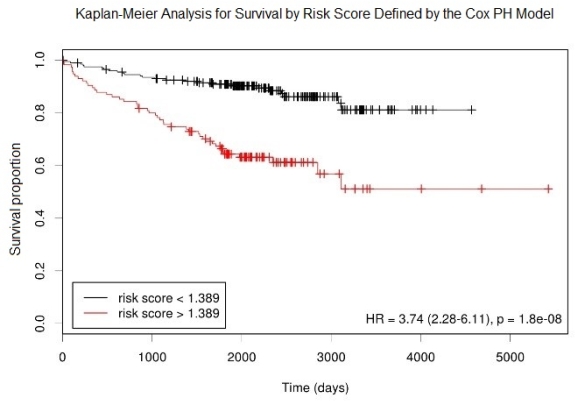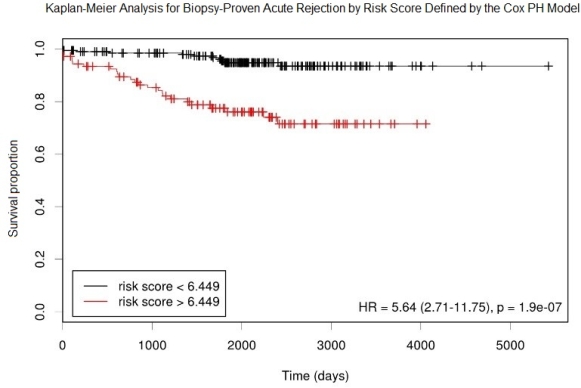Multivariate Cox Proportional Hazards Model for Estimating Long-Term Risk of Aging Kidney Transplant Recipients
Henry Ford Transplant Institute, Detroit, MI.
Meeting: 2018 American Transplant Congress
Abstract number: D193
Keywords: Age factors, Kidney transplantation, Multivariate analysis, Outcome
Session Information
Session Name: Poster Session D: Kidney: Acute Cellular Rejection
Session Type: Poster Session
Date: Tuesday, June 5, 2018
Session Time: 6:00pm-7:00pm
 Presentation Time: 6:00pm-7:00pm
Presentation Time: 6:00pm-7:00pm
Location: Hall 4EF
Purpose: The growing number of elderly kidney transplant recipients (KTR) presents an opportunity to analyze and predict long-term outcomes and risk in this aging population.
Methods: A single-center retrospective analysis of medical records from 2003-10 for KTR aged 40-79 on mycophenolate, tacrolimus, and steroid regimen was performed. Baseline variables including age, induction therapy, type of transplant, gender, and race were included in the multivariate Cox proportional hazards (PH) model for mortality, biopsy-proven acute rejection (BPAR), and graft failure (GF). Linear combination of model predictors weighted by regression coefficients in Cox PH model were used as a risk score for events. An optimal cut-off point was selected to classify patients into low vs high groups whereby the log-rank test statistic contrasting the groups would be maximized. Kaplan-Meier (KM) curves and log-rank test were used to assess the survival profiles.
Results: 318 KTR were reviewed with median follow-up of 2120 days. Older age is associated with increased hazard ratio (HR) for mortality [1.04 (1.01, 1.06), p=0.003] and decreased HR for BPAR [0.96 (0.94, 0.98), p<0.001], but not associated with GF. KM plots reveal low and high risk groups defined by fitted Cox PH models have significant separation (p<0.001) for survival and BPAR.
Other findings are increased HR for BPAR for recipients of living unrelated donors [2.23 (1.04, 4.82), p=0.04] vs living related donors and African Americans [1.79 (1.11, 2.92), p=0.02] vs Caucasians. Females experienced decreased HR [0.52 (0.33, 0.83), p=0.01] vs males for BPAR.
Conclusion: The predictive model for KTR informs clinicians of the risks of transplanting an aging population. For every year that age increases, KTR have a lower risk of experiencing BPAR, but a greater risk of mortality.
CITATION INFORMATION: Yaldo A., Bajjoka I., Han X., Crombez C., Abouljoud M. Multivariate Cox Proportional Hazards Model for Estimating Long-Term Risk of Aging Kidney Transplant Recipients Am J Transplant. 2017;17 (suppl 3).
To cite this abstract in AMA style:
Yaldo A, Bajjoka I, Han X, Crombez C, Abouljoud M. Multivariate Cox Proportional Hazards Model for Estimating Long-Term Risk of Aging Kidney Transplant Recipients [abstract]. https://atcmeetingabstracts.com/abstract/multivariate-cox-proportional-hazards-model-for-estimating-long-term-risk-of-aging-kidney-transplant-recipients/. Accessed January 7, 2026.« Back to 2018 American Transplant Congress


